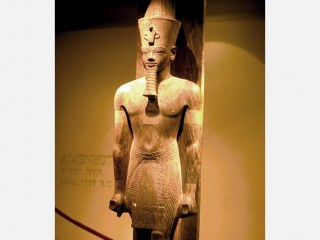
Amenhotep III biography
Date of birth : -
Date of death : -
Birthplace : Ancient Egypt
Nationality : Egyptian
Category : Historian personalities
Last modified : 2010-11-26
Credited as : Pharaoh of Egypt, ,
Amenhotep III (reigned 1417-1379 B.C.) was the ninth ruler of the Eighteenth Dynasty of Egypt. The Pharaoh was a patron of the arts, and during his reign magnificent buildings and sculptures were created.
Amenhotep III came to the throne at a time when his country was at the height of its political power, economic prosperity, and cultural development. As a result of the conquests of his predecessors, particularly Thutmose I and III, Egypt was a dominant power in the Near East, and its sphere of influence stretched from the Fourth Cataract of the Nile to the banks of the Euphrates. Throughout his long and peaceful reign, Amenhotep combined the pursuit of worldly pleasures with a program of self-glorification on a scale grander than any undertaken before.
Amenhotep's reign may be divided into two phases. During his first 10 years he exhibited his skill and prowess as a sportsman in a series of big-game hunts, which were accorded wide publicity. His military career appears to have consisted of a single, relatively unimportant expedition into Upper Nubia in the fifth year of his reign. There is no mention of hunting expeditions after the tenth year or indeed of any activity involving the Pharaoh in physical exertion. In the tenth year Amenhotep arranged a marriage between himself and Gilukhipa, daughter of Shuttarna, King of Mitanni.
The second phase of Amenhotep's reign consisted of nearly 3 decades of luxurious ease, which witnessed an unparalleled output of splendid architectural works, sculpture, and fine craftsmanship. From the middle of his reign onward, Amenhotep probably spent much time amid the luxury of his great palace in western Thebes. Throughout this period the dominant influence in his life was his queen, Tiy, the daughter of a commoner. She occupied this unprecedented position not only in Amenhotep's reign but also in that of their son Ikhnaton.
Amenhotep's mortuary temple on the western plain at Thebes, which was demolished during the Nineteenth Dynasty, was apparently the largest of its class ever built. The two gigantic statues of the Pharaoh, the so-called Colossi of Memnon, which stood in front of the temple, still tower over the plain. Although the Aten (sun disk) probably emerged as a recognized member of the Egyptian pantheon during the reigns of Thutmose III and Amenhotep II, it was not until the reign of Amenhotep III that the new god was officially honored, when the Pharaoh named his flagship and a royal palace after the deity.
During the last decade of his reign Amenhotep was ill and prematurely senile, but there was no reduction in his building activities or the scale of luxury in which he lived. He died at the age of about 55 and was buried in a huge, rock-cut tomb prepared for him in the western branch of the Valley of the Kings.
A well-illustrated account of the reign of Amenhotep III is given in Cyril Aldred, Akhenaten, Pharaoh of Egypt: A New Study (1968). This should be read in conjunction with William C. Hayes's chapter "Egypt: Internal Affairs from Tuthmosis I to the Death of Amenophis III" in I.E.S. Edwards, C.J. Gadd, and N.G.L. Hammond, eds., The Cambridge Ancient History, vol. 2 (2d ed. 1962).
















